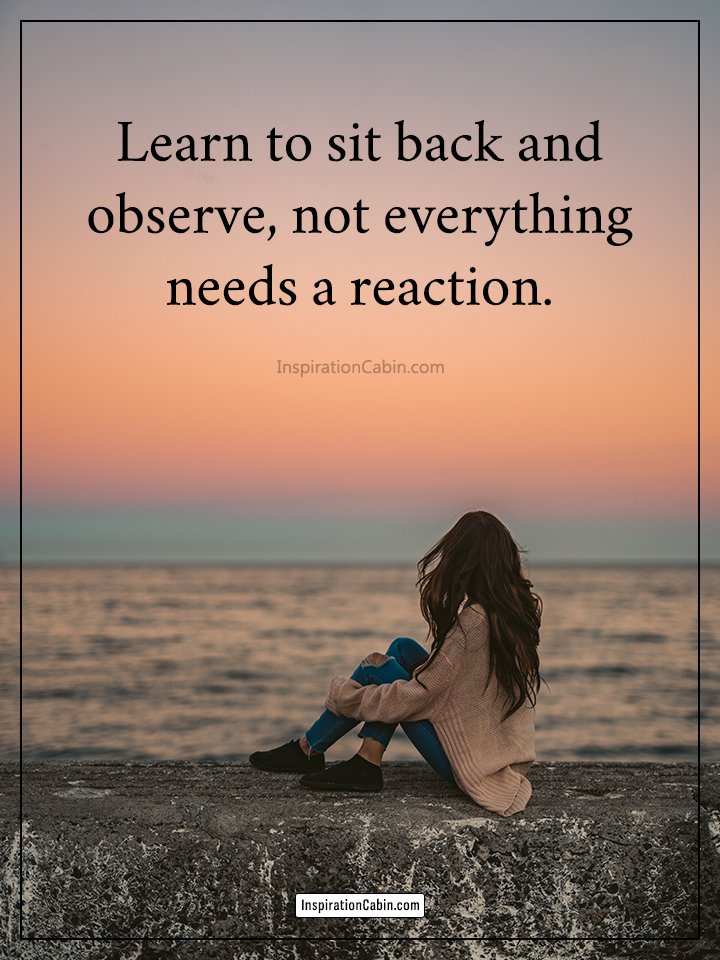Learn To Sit Back And Observe.Not Everything Need

In the frenetic symphony of modern life, the pressure to react instantaneously reigns supreme. From the incessant ping of notifications to the ever-present churn of the news cycle, our environments conspire to keep us in a state of perpetual reactivity. We hurtle from one stimulus to the next, firing off responses with the alacrity of a well-oiled machine. Yet, amidst this relentless dance, a potent antidote exists – the art of non-reactivity and mindful observation.
Non-reactivity isn’t about apathy or indifference. It’s a conscious choice to pause, to step back from the cacophony, and observe situations with a discerning eye before engaging. It’s about recognizing that not every situation demands an immediate response, and that a measured pause can empower us to respond with greater clarity and intention.
The relentless cycle of reaction carries a hefty price tag. Decision fatigue, a state of mental exhaustion brought on by the constant barrage of choices, can lead to impulsive and often suboptimal decisions. The constant churn of emotional responses fuels stress and emotional dysregulation, making us vulnerable to hijackings by our amygdala, the brain’s primal fear center. Furthermore, our knee-jerk reactions can exacerbate conflict, creating a domino effect of negativity that engulfs everyone involved.
By cultivating non-reactivity, we unlock a treasure trove of benefits. Stepping back allows for a deeper understanding of ourselves and our emotions, fostering enhanced self-awareness and emotional intelligence. This newfound clarity empowers us to make more informed decisions, navigate challenges with greater finesse, and approach problem-solving with a newfound sense of composure. Moreover, non-reactivity fosters empathy. By observing situations dispassionately, we gain a broader perspective, allowing us to connect with the underlying emotions and motivations of others, strengthening our relationships.
Developing the art of observation is the cornerstone of non-reactivity. Mindfulness practices, such as meditation and deep breathing, cultivate a heightened awareness of the present moment, enabling us to detach from the mental chatter and observe situations with a clear, unbiased lens. Active listening, a cornerstone of effective communication, involves truly paying attention to the speaker’s verbal and nonverbal cues, fostering a deeper understanding of their message. Finally, honing the ability to observe situations objectively and dispassionately allows us to separate fact from opinion and emotional bias, leading to more nuanced and insightful responses.
Implementing non-reactivity in daily life requires a dedicated effort. Here are some practical strategies:
- The Pause Technique: In the heat of the moment, consciously take a pause before reacting. Breathe deeply, count to ten, or simply excuse yourself momentarily. This brief space allows the initial emotional charge to dissipate, paving the way for a more thoughtful response.
- Reframing Situations: When faced with a challenge, actively reframe the situation by viewing it from different perspectives. Ask yourself, “Is this situation as dire as it initially seems?” or “What alternative interpretations are possible?” Reframing fosters a sense of agency and empowers us to identify potential solutions.
- Detachment with Compassion: Acknowledge your emotions without judgment. Notice them arise, observe their characteristics, and then allow them to pass without getting swept away. This practice cultivates emotional resilience and fosters a sense of self-compassion that can extend to others.
Non-reactivity is not a one-time feat; it’s an ongoing practice. With consistent effort, it becomes ingrained in our responses, transforming our interactions with the world around us. By embracing mindful observation, we liberate ourselves from the tyranny of immediate reaction. We become more thoughtful communicators, more effective problem-solvers, and ultimately, architects of our own well-being. The transformative power of non-reactivity lies in its ability to empower us to respond, not react, to navigate the complexities of life with greater grace and wisdom.
The Ripple Effect: Non-Reactivity Beyond the Individual
The transformative power of non-reactivity extends far beyond the individual. It creates a ripple effect, positively impacting our relationships, workplaces, and even broader societal dynamics.
Strengthening Relationships: By adopting a more observant approach, we become more attuned to the subtle cues and emotional nuances of those around us. This fosters deeper empathy and understanding, paving the way for more meaningful connections. We become better listeners, offering genuine support and avoiding knee-jerk reactions that may inadvertently push loved ones away. Non-reactive communication also minimizes conflict by allowing us to address issues calmly and rationally, fostering a sense of trust and respect within our relationships.
Enhanced Workplace Dynamics: In the fast-paced world of work, pressure and deadlines often lead to reactivity. Non-reactive leaders inspire trust and collaboration by fostering open communication and actively listening to diverse perspectives. They approach conflict with a sense of calm composure, facilitating productive solutions and maintaining a positive work environment. This mindful approach translates to a more engaged workforce, leading to increased productivity and innovation.
Societal Impact: In today’s hyper-connected world, negativity and misinformation can spread rapidly, fueling social division and conflict. Non-reactivity encourages us to pause and critically evaluate information before sharing it. It fosters a more civil discourse, allowing for constructive dialogue and the pursuit of common ground. By approaching complex issues with a discerning eye and a willingness to listen, we can contribute to a more peaceful and collaborative society.
Cultivating a Culture of Non-Reactivity:
While non-reactivity is a personal practice, fostering a culture of non-reactivity within our communities can amplify its benefits. This can be achieved by:
- Leading by Example: When faced with challenging situations, model calm and thoughtful responses. This encourages others to do the same.
- Promoting Open Communication: Create safe spaces for open and honest dialogue where diverse perspectives can be heard without judgment.
- Mindfulness Practices: Integrate mindfulness practices into group activities or workshops. This can help individuals develop their own capacity for non-reactivity.
The Journey of Non-Reactivity:
The path to non-reactivity is a continuous journey, not a destination. There will be times when ingrained patterns take hold, and immediate reactions surface. When this happens, acknowledge the slip-up with kindness and gently redirect your focus. With consistent practice, non-reactivity becomes a powerful tool, empowering us to navigate the complexities of life with greater clarity, compassion, and wisdom. It allows us to step out of the whirlwind of reaction and become mindful participants in shaping our own lives and the world around us.
In conclusion, non-reactivity is not about disengagement; it’s about mindful engagement. It empowers us to respond with intention rather than react impulsively. By embracing the power of observation and cultivating a culture of non-reactivity, we can foster stronger relationships, create more positive workplaces, and contribute to a more peaceful and harmonious society. So, the next time you feel the urge to react, take a breath, step back, and observe. You might be surprised by the clarity and wisdom that emerges.



